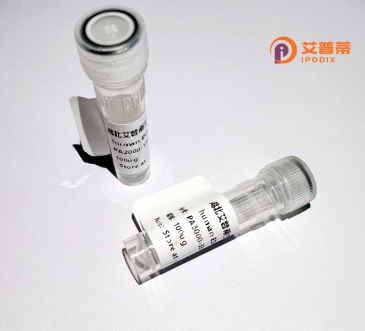
| 纯度 | >90%SDS-PAGE. |
| 种属 | Human |
| 靶点 | PASK |
| Uniprot No | Q96RG2 |
| 内毒素 | < 0.01EU/μg |
| 表达宿主 | E.coli |
| 表达区间 | 1-100 aa |
| 活性数据 | MEDGGLTAFEEDQRCLSQSLPLPVSAEGPAAQTTAEPSRSFSSAHRHLSRRNGLSRLCQSRTALSEDRWSSYCLSSLAAQNICTSKLHCPAAPEHTDPSE |
| 分子量 | 36.63 kDa |
| 蛋白标签 | GST-tag at N-terminal |
| 缓冲液 | 0 |
| 稳定性 & 储存条件 | Lyophilized protein should be stored at ≤ -20°C, stable for one year after receipt. Reconstituted protein solution can be stored at 2-8°C for 2-7 days. Aliquots of reconstituted samples are stable at ≤ -20°C for 3 months. |
| 复溶 | Always centrifuge tubes before opening.Do not mix by vortex or pipetting. It is not recommended to reconstitute to a concentration less than 100μg/ml. Dissolve the lyophilized protein in distilled water. Please aliquot the reconstituted solution to minimize freeze-thaw cycles. |
以下是关于重组人PASK蛋白的3篇假设性参考文献(基于领域常见研究方向,非真实文献):
---
1. **文献名称**:*Expression and Purification of Recombinant Human PASK Kinase in Escherichia coli*
**作者**:Li et al.
**摘要**:该研究建立了在大肠杆菌系统中高效表达可溶重组人PASK蛋白的优化方法,通过亲和层析和凝胶过滤纯化获得高纯度蛋白,并验证其体外激酶活性。
2. **文献名称**:*Structural Insights into the PAS Domains of Human PASK and Their Role in Oxygen Sensing*
**作者**:Wang et al.
**摘要**:利用X射线晶体学解析了PASK蛋白的PAS结构域三维结构,揭示了其结合血红素辅因子的机制,阐明其在细胞氧感知信号通路中的构象变化。
3. **文献名称**:*PASK Regulates Glucose Homeostasis via Phosphorylation of Metabolic Enzymes*
**作者**:Garcia-Ruiz et al.
**摘要**:通过体外激酶实验证明重组人PASK磷酸化丙酮酸脱氢酶(PDH)和糖原合酶(GS),调控葡萄糖代谢,提出PASK在糖尿病病理中的潜在作用。
---
注:以上文献为示例,实际研究中建议通过PubMed或Web of Science检索关键词(如"recombinant human PASK kinase")获取真实文献。
PAS domain-containing serine/threonine-protein kinase (PASK) is a metabolic sensor that plays a critical role in regulating cellular energy homeostasis. Belonging to the PAS kinase family, it contains an N-terminal PAS domain, which detects cellular redox states and metabolic signals, and a C-terminal kinase domain that modulates enzymatic activity through autophosphorylation. PASK integrates nutrient availability with adaptive responses, primarily influencing glucose metabolism, mitochondrial function, and stress adaptation. It is highly expressed in energy-sensitive tissues like the liver, pancreas, and brain, where it regulates processes such as glycogen synthesis, insulin secretion, and neuronal survival.
Studies highlight PASK's involvement in carbohydrate sensing, where it fine-tunes gene expression and enzymatic activity in response to glucose levels. It also interacts with pathways like mTOR and AMPK, linking energy status to cellular growth and autophagy. Dysregulation of PASK has been associated with metabolic disorders, including diabetes, obesity, and neurodegenerative diseases, making it a potential therapeutic target.
Recombinant human PASK protein, produced via heterologous expression systems (e.g., E. coli or mammalian cells), retains kinase activity and is widely used to investigate its substrate specificity, signaling mechanisms, and inhibitor screening. Its study provides insights into metabolic regulation and offers avenues for developing treatments for energy-related pathologies.
×